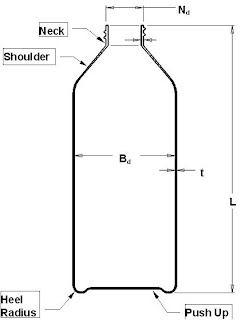Optimize Primary Blow Delay (Start) for ISBM
The purpose of the Primary Blow Air is to inflate the preform as much as possible to the final shape of the container. The setting of the Primary Blow Delay time is one of the most critical processing adjustments that can be made in the molding process. Very small changes can have a significant effect on the container quality. There is no "correct" setting for Primary Blow Delay. The optimum setting will depend on many other factors upstream of the stretch blow process and it is also important to understand that the optimum setting will change if one of those upstream conditions changes. Therefore, adjusting the Primary Blow Delay time should be one of the last processing adjustment to be made when setting up a machine.
If Primary Blow Delay is too early, the container may suffer from neck rings or off center gates. If it is too late, the shoulder may show a grainy appearance, there may be a constriction or the preform may split in the body.
If there is insufficient inflation in the primary blow, the extreme high pressure of the secondary blow may cause damage to the inflating preform such as pearlescence in the corners, splitting in the base.
It is nearly impossible to judge the effect of the Primary Blow air on the inflation of the preform if the Secondary Blow air is also operating normally. Therefore, the first step is to disable the Secondary Blow air, after which the primary air time setting can be adjusted to various settings to find the optimum.
Optimize Primary Blow Delay (Start) for Injection Stretch Blow Molding
1. Increase the setting of the Secondary Blow Delay timer to the same or more than the Blow timer. This will prevent the Secondary Blow from taking place.
2. Reduce the Primary Blow Delay time to 0.0 seconds.
3. Start the machine, allow the preform temperature to stabilize, then turn on the blow mold. Take a sample then increase the Primary Blow Delay setting, this should be about 0.05~0.1 seconds per step. Collect a sample container at each step, mark it and place it on a table. At some point, the container quality will go bad, typically this will be a constriction mark around the shoulder area. There is no point in going any further once this happens and it is possible that a stretch rod tip may be broken if you continue.
4. Stop the machine and study the sample bottles produced, it is likely that the quality will have gone through a range as shown by the red curved line, somewhere around the middle setting, the best formed bottle will be seen. This is the optimum setting for the Primary Blow Delay timer.
5. After the Primary Blow Delay has been optimized, you should then optimize the Secondary Blow Delay setting.
The technique used here can also be applied to the Primary Blow pressure and Primary Blow flow settings.
Some container designs, notably square and flat-oval shapes are very sensitive to these adjustments, whereas round simple shapes may not be.
If Primary Blow Delay is too early, the container may suffer from neck rings or off center gates. If it is too late, the shoulder may show a grainy appearance, there may be a constriction or the preform may split in the body.
If there is insufficient inflation in the primary blow, the extreme high pressure of the secondary blow may cause damage to the inflating preform such as pearlescence in the corners, splitting in the base.
It is nearly impossible to judge the effect of the Primary Blow air on the inflation of the preform if the Secondary Blow air is also operating normally. Therefore, the first step is to disable the Secondary Blow air, after which the primary air time setting can be adjusted to various settings to find the optimum.
Optimize Primary Blow Delay (Start) for Injection Stretch Blow Molding
1. Increase the setting of the Secondary Blow Delay timer to the same or more than the Blow timer. This will prevent the Secondary Blow from taking place.
2. Reduce the Primary Blow Delay time to 0.0 seconds.
3. Start the machine, allow the preform temperature to stabilize, then turn on the blow mold. Take a sample then increase the Primary Blow Delay setting, this should be about 0.05~0.1 seconds per step. Collect a sample container at each step, mark it and place it on a table. At some point, the container quality will go bad, typically this will be a constriction mark around the shoulder area. There is no point in going any further once this happens and it is possible that a stretch rod tip may be broken if you continue.
4. Stop the machine and study the sample bottles produced, it is likely that the quality will have gone through a range as shown by the red curved line, somewhere around the middle setting, the best formed bottle will be seen. This is the optimum setting for the Primary Blow Delay timer.
5. After the Primary Blow Delay has been optimized, you should then optimize the Secondary Blow Delay setting.
The technique used here can also be applied to the Primary Blow pressure and Primary Blow flow settings.
Some container designs, notably square and flat-oval shapes are very sensitive to these adjustments, whereas round simple shapes may not be.



Comments